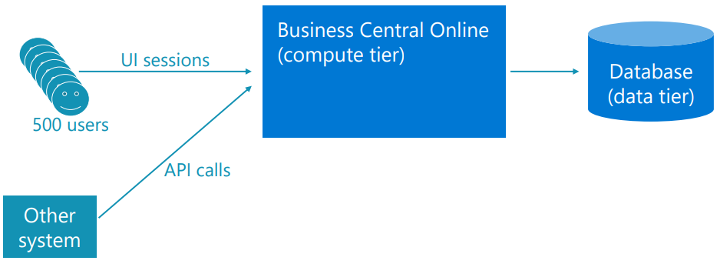It has proven reliability and is supporting larger and larger customers. The infrastructure has been designed to scale – without limits.
At the Directions Lyon conference in 2023, Microsoft shared that Dynamics 365 Business Central production environments had uptime of 99.98% in the previous three months – that means a maximum of nine minutes of downtime per month! While that’s a super SLA performance, how can we be sure that Business Central Online can cater for larger businesses?
In this blog, we will set out how the Business Central Online platform scales automatically and will also give you examples of real Business Central customer processing volumes, which you can use to compare to your processing requirements.
Load balancing – automatically scaling!
Load balancing in Business Central is a really great feature. Let’s explore how this works in practice. Essentially user and web service sessions connect to a compute tier which manages database access. The compute tier is comprised of a set of VMs that run the various components from the user UI sessions and API calls.

Microsoft monitor the load on each VM in a cluster – specifically they look at the CPU load. Once any of the VMs are over 60%, they will start a new VM and transfer the excess load to that VM. Where all VMs in a cluster reach 60%, they will ‘scale-out’ the cluster based on a workload algorithm. Microsoft’s goal is to achieve 99.95% of all UI session minutes being served by VMs with plenty of capacity. Their recently published performance was 99.81%.
To put this in context, for a user who works directly in BC for twenty hours per week would only have just over two minutes where there was restricted capacity for the UI session.
Similarly, the data tier is also designed to scale. The load for a database is quantified by looking at the CPU, Data I/O and Log Write load. If any of these factors has been high for more than half of the previous thirty minutes, then the data tier will automatically scale-out. The auto-scaling is so effective that 99.85% of all databases were never overloaded.
Large transaction volumes
Despite this, we are regularly asked if Business Central Online ready for large customers, or will it break under a large load. Many customers are concerned that their system requires hundreds of users, that they have very large transaction volumes and a large database, or that they have a very high level of API calls. So let me share below some examples of actual Business Central Online customers that you can use to compare to your requirements:
- Sales orders – 4,000 sales orders in one hour with 150,000 lines
- Sales invoice posting – 5,000 invoices in one hour
- Users – lots of systems with over 1,000 users and thousands of systems with over 100 users
- Database size – many databases over 100GB and several up to 1TB
- Web service calls – 10 million in one day in a single environment – 1 million in one hour – 25k in one minute
- Job queues – 350k in one day – 15k in one hour – 300 in one minute
Please note that the above numbers are not limits, and they’re not even the highest level of what Business Central Online can handle – this is data recorded from actual customer systems!
Operational limits
Many of the previous operational limits have now been removed, so there are now no operational limits on the number of users, the database size, or the number of browser interactions. There are some new operational limits, but as you will see, these are highly unlikely to be restrictive!
- Job Queue scheduled tasks: 5 concurrently running tasks per user
- Web service requests: 6,000 web service requests per user in the previous 5-minute sliding window
- Concurrency limits for web service requests: 100 concurrently handled (5 processed, 95 queued) web service requests per user
The most significant change is that, from Business Central 2023 Wave 2, operational limits change from a per-environment limit to a more scalable per-user limit, meaning that the more users you have, the higher the limits will be!
In summary
Yes! Business Central Online platform is proven to be reliable and based on the actual customer processing data, it is scalable for larger businesses. We chat with customers every day about upgrading to Business Central, and on average, we upgrade a customer to Business Central Online every week!
Even though we are fully committed to supporting our customers who are still using Dynamics NAV and Business Central on-premise, we strongly recommend that you should make a plan to upgrade to Business Central Online (SaaS).